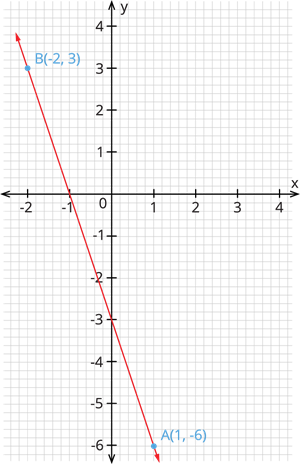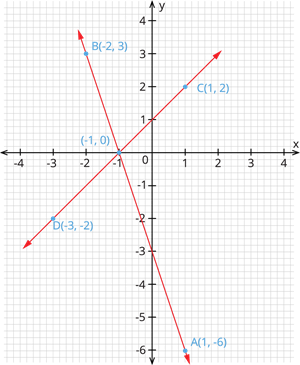UPSKILL MATH PLUS
Learn Mathematics through our AI based learning portal with the support of our Academic Experts!
Learn moreWe have learnt how to plot the points in a graph. Now, we shall learn how to draw a straight line in a graph.
Joining any two points in the graph will give us a straight line.
Example:
1. Draw a straight line by joining the points \((1,-6)\) and \((-2,3)\).
Solution:
Step \(1\): Plot the point \((1,-6)\) in the quadrant \(IV\) and name it as \(A\).
Step \(2\): Similarly, plot the point \((-2,3)\) in the quadrant \(II\) and name it as \(B\).
Step \(3\): Now, joining the points \(A\) and \(B\) and extending it, we get a straight line.

Here, the straight line intersects the \(x\) - axis at \((-1,0)\) and \(y\) - axis at \((0,-3)\).
2. Draw straight lines by plotting the points \((1,-6)\), \((-2,3)\), \((1,2)\) and \((-3,-2)\).
Solution:
Step \(1\): Plot the point \((1,-6)\) in the quadrant \(IV\) and name it as \(A\). 
Step \(2\): Similarly, plot the point \((-2,3)\) in the quadrant \(II\) and name it as \(B\).
Step \(3\): Plot the point \((1,2)\) in the quadrant \(I\) and name it as \(C\).
Step \(4\): Plot the point \((-3,-2)\) in the quadrant \(III\) and name it as \(D\).
Step \(5\): Now, join the points \(A\), \(B\) and \(C\), \(D\).
Step \(6\): After joining, we can see that the lines intersect at the point \((-1,0)\).
